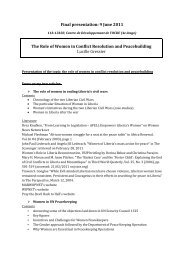Women's Economic Opportunity Index - Economist Intelligence Unit
Women's Economic Opportunity Index - Economist Intelligence Unit
Women's Economic Opportunity Index - Economist Intelligence Unit
- No tags were found...
You also want an ePaper? Increase the reach of your titles
YUMPU automatically turns print PDFs into web optimized ePapers that Google loves.
Appendix IWomen’s economic opportunityA new global index and rankingRural Poverty Assessment: Near East and North Africa, International Fund for Agricultural Development:Rome, August 1999.127. D Klepinger, S Lundbergand R Plotnick, “How DoesAdolescent Fertility Affect theHuman Capital and Wages ofYoung Women?”, Journal ofHuman Resources, Vol. 34, No. 3,summer 1999, pages 421-448.128. A T Geronimus and SKorenman, “The SocioeconomicConsequences of TeenChildbearing Reconsidered”, PSCResearch Report No. 90-190,September 1990.129. M Buvinic, “The Costsof Adolescent Childbearing:Evidence from Chile, Barbados,Guatemala and Mexico”, Studiesin Family Planning, Vol. 29, No.2, The Population Council, 1998.130. Adolescent Girls’Livelihoods, Population Counciland International Centre forResearch on Women: New Yorkand Washington DC, 2000.131. S Mathur, M Greene and AMalhotra, Too Young to Wed: TheLives, Rights, and Health of YoungMarried Girls, InternationalCentre for Research on Women:Washington DC, 2003.132. 2009 World Survey on theRole of Women in Development:Women’s Control over <strong>Economic</strong>Resources and Access toFinancial Resources, includingMicrofinance, UN Departmentof <strong>Economic</strong> and Social AffairsDivision for the Advancement ofWomen, ST/ESA/326, UN: NewYork, 2009.133. C Grown, G Rao Gupta andA Kes, Taking Action: AchievingGender Equality and EmpoweringWomen. Report of the MillenniumProject Task Force on Educationand Gender Equality, Earthscanfor the UN Task Force onEducation and Gender Equality:London, 2005.134. A Ellis, C Manuel and C MBlackden, Gender and <strong>Economic</strong>Growth in Uganda: Unleashingthe Power of Women, Directionsin Development, World Bank:Washington DC: 2006.Adolescent Fertility RateThe literature suggests that there is a negative correlation between adolescent motherhood and economicopportunity for young women. For example, Klepinger et al (1999) analysed data from a sample of womenin the US National Longitudinal Survey of Youth, and found that adolescent fertility substantially reducesyears of formal education and work experience. These reductions in human capital resulted in a significanteffect on wages at the age of 25. 127 Other studies in the US attribute a large part of the negative economicconsequences to prior social and economic disadvantages, and not to teenage child-bearing. 128 Themain empirical challenge in assessing the impact of early childbearing is to isolate the causal impact ofbecoming a young mother from the mother’s socio-economic background.In developing countries, there is empirical evidence that suggests a negative correlation betweenadolescent motherhood and decreased economic opportunity for young women. A four-country studyin Chile, Barbados, Guatemala and Mexico shows evidence from all four countries that adolescentmotherhood is associated with adverse socio-economic conditions and poor earning opportunities forthe teenage mother. 129 After controlling for the mother’s schooling and her wealth as a child, both theGuatemala and the Mexico studies found that adolescent child-bearing was positively associated withpoverty indicators (measured by an index of housing quality in Guatemala, and an index of housingquality and socio-economic standing in Mexico. The Chile study suggests that early childbearing andclosely associated factors can have significant economic costs, especially for poor mothers who needthose earnings most. Early childbearing seems to entrench the poverty trajectory of poor women.Research shows that most very young mothers work in the informal sector or perform unpaid economicactivity in the home. 130 Young married mothers in developing countries tend to be primarily responsiblefor household-related tasks, and they have limited access to productive resources such as land, housing,credit, water and agricultural technical assistance. 131 All these constraints add up to limit a youngwoman’s opportunities to access jobs, earn an income and improve her livelihood.Further ReadingGiving Girls Today and Tomorrow: Breaking the Cycle of Adolescent Pregnancy, UN Population Fund: NewYork, 2007.Property Ownership RightsProperty ownership is still very unequal between women and men in many countries. This is due to acombination of discriminatory inheritance practices, unequal access to land markets and gender-biasedland reform. 132 For women, this is a double blow in terms of not having sufficient control over resourcesto increase agricultural productivity and food security, 133 and reducing their ability to access incomegeneratingopportunities through non-farm business, especially through the use of immovable assets ascollateral for business loans. 134123 <strong>Economist</strong> <strong>Intelligence</strong> <strong>Unit</strong> 2010




